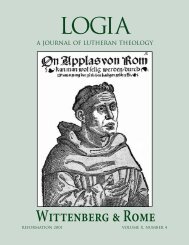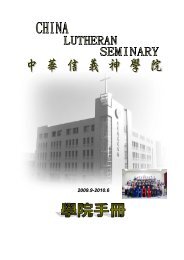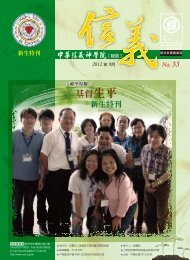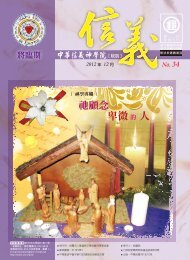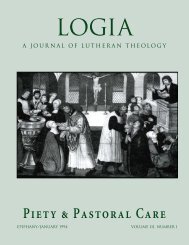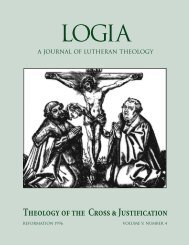04-2 Hermeneutics.pdf
04-2 Hermeneutics.pdf
04-2 Hermeneutics.pdf
- No tags were found...
You also want an ePaper? Increase the reach of your titles
YUMPU automatically turns print PDFs into web optimized ePapers that Google loves.
THE AUTHORITY OF SCRIPTURE 27Second, allegory had been used by the church to bridge therecognized gap between contemporary life and the past historicalnarrative. Allegory was seen as making the Scriptures relevant tocontemporary Christians. In contrast, Luther understood that theliteral sense itself was able to create contemporaneity by transcendinghuman historical time and speaking a relevant word toany time and at any place. The authoritative text of Scripturebrought Christ himself into the presence of the reader. 25 Thegood news, spoken of old, sounded continually for Luther and hiscontemporaries whenever the gospel word was read and proclaimedin their own hearing with faith.Such a contemporary and authoritative word had relevancebeyond a mechanical literalism. As Luther studied and becamesaturated in the biblical and especially the Pauline texts, he rediscoveredthe authoritative word, which would be a model for hishermeneutics. Luther returned to a Pauline concept of allegory asa faith illustration.Allegory was not merely a tool to “find Christ” in the text ofthe Old Testament, although that was possible from Luther’sgospel perspective. 26 Whenever Luther saw Paul or Christ usingallegory, he recognized that it was only another way of saying orillustrating the same thing by depicting it verbally. This is particularlyclear in the Galatians commentaries, which we shall nowbriefly survey.The Galatians Lectures and CommentariesThe one instance in Scripture of the term “allegory” (Gal4:24) is the most logical starting point for approaching Luther’sbiblical scholarship. An investigation into Luther’s multiple workswith Galatians—at least six can be distinguished—especially ashe made comments on Galatians 4:24, serves well as the primaryfocus to answer the question of Luther’s understanding and useof allegory. From an investigation into these works several conclusionscan be drawn. 27Three early works consist of his original lectures from October27, 1516, to March 13, 1517; the resulting commentary releasedin September of 1519; an abridged version of 1523; and a Germantranslation in 1525. Luther’s second series on this beloved epistlewas begun on July 3, 1531, and concluded in December of thatyear. This later lecture series served as the basis for a commentaryon Galatians in 1535, from which a slightly expanded version in1538 became known as Luther’s Galatians Commentary.The Early Work (1516–25)Allegory, for obvious historical reasons, played a more prominentplace in the earliest works on Galatians by Luther. Both as anobject of concern as well as a subject of comment, allegory and themedieval quadriga were frequently cited. 28 Allegory as alieniloquium(“other speaking”) is affirmed in these early works; eventhe German translation by Vincent Heydnecker refers to allegoryas “something covered or hidden.” 29 References to the quadriga,the fourfold method of interpretation, are made as a matter ofcourse both in the lectures and in the commentaries.Yet Luther underscored and affirmed the historical reality ofthe allegorical material; for example, Luther is quick to state thatthe allegorical use of the Hagar and Sarah accounts from Genesisdoes not deny their being true, factual, and historical charac-ters. 30 This accentuates Luther’s misgivings of those exegetes whosaw in allegory only a fictive account that could be played withindiscriminately. In the 1519 commentary he called that approachto allegory “a game.” 31 On the other hand, the historical realitydid not provide a license to read Scripture merely for its historicalor narrative content. There was more intended in the biblical textthan an empty, legalistic letter.Luther repeated Augustine’s distinction between letter andspirit and affirmed that the letter denoted a biblical interpretationthat lacked the grace and love of God. Spirit, on the other hand,referred to the grace-filled and life-giving message of forgivenessand salvation in Christ Jesus; it was a word of God’s activity forthe human condition. 32 When reading a text, it was not the taskof an interpreter merely to read the literal text and expound it,but to find the gospel, the good news of salvation for lost andcondemned sinners.Allegory was not merely a tool to “findChrist” in the text of the Old Testament.nbAllegory had to relate to grace and justification if it were toprovide a proper understanding of a text. Or as Luther was wontto say in his later Galatians lectures, “allegories are meant to containChrist.” 33 Thus the authority of Scripture lay in the Christocentriccontent that could be discovered only in the literal text.The literal text was to serve as the authoritative basis for alldoctrinal arguments. Allegory was never to be a principal tool forbiblical interpretation. This also was a feature and methodologicalpresupposition of Luther’s medieval tradition from the Victorines,Thomas Aquinas, and even Lyra. 34Allegory was to teach doctrines, not serve as a basis for makingor establishing doctrinal formulations. This subtle yet vitaldistinction shaped Luther’s understanding and application ofallegory. Allegory was an ornament, an illustration, a biblicalallusion, which was used to apply a text to contemporary situations.For example, in the early commentaries Luther saw theillustration used by Paul in Galatians of sowing and reaping andcould apply it to Christian sanctification. 35Such illustrations were designed specifically for Christians,that is, specifically for believers who had a grasp of the spiritualdimension of life and had faith instilled in them. These GalatianChristians, Luther acknowledged, were weak. As weak believers,they needed to be entertained in order to receive the edifying messageof the gospel. Allegory served in that capacity adequately. 36Luther did criticize exaggerated and mechanical uses of thequadriga. He said that the practice of seeking four specific anddistinct senses was not Pauline, scriptural, patristic, or evengrammatical. He concluded that, because there was not a strongprecedent in Scripture for its use, such a fourfold requirementshould not be demanded as theologically necessary. 37 Allegorywas particularly harmful when it was viewed as being better orhigher than the literal, the grammatical-historical sense.






